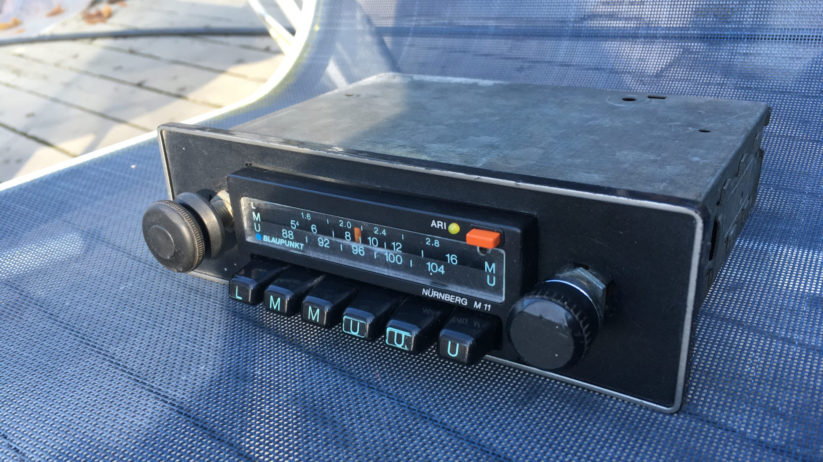Things are on hold with Hampton, the 48,ooo-mile ’73 2002, while I wait for the original water pump to be rebuilt and shipped back, so I thought I’d turn my gaze rearward for a bit. We baby boomers came of age when car audio was rapidly improving. First there was AM radio. Then AM/FM. Then FM stereo and tape, giving the ability to select your own music.
I worked in a stereo store when I was in junior high school, so I was exposed to what was then high-end audio. To hear something like Emerson Lake and Palmer’s Lucky Man pounding over a big set of Infinity 2000 speakers driven by a Phase Linear 700-watt power amp was transformative; suddenly the little Sony transistor radio in my bedroom and the in-car tunes in my mother’s ’69 Plymouth Satellite were a cosmic joke. I needed more.
When my mother bought a Fiat 128 just before I got my driver’s license in 1975, I begged her to let me install a stereo. I bought some cheap FM-only thing with a form-factor like a slim paperback book, used shelving brackets to hold it to the underside of the dash with all the subtlety and elegance of the bolts in Frankenstein’s monster’s neck, and laid a pair of AR-2 speakers that I’d bought at a yard sale across the back seat. My mother sort of shrugged, as she did with many things, and thought, “Well, if it’s important to him….” The radio whined as I revved the engine up due to ignition interference, but I didn’t care.
When I bought my first car in 1976, the notorious 1970 Triumph GT6+ that I owned for a couple of years, it came with—and I swear I am not making this up—both a cassette player and an FM/eight-track deck, something you wouldn’t think possible in that tiny interior. The cassette player was shoehorned into the center console where the radio originally was, and the eight-track was cajoled into hanging above my left knee with an odd assortment of brackets. But I thought it was great; I had arrived. I had a cool car and tunes. The car came with an Eagle’s Greatest Hits cassette and Gary Wright’s The Dream Weaver on eight-track. They’re both forever burned into my brain. In my head, any GT6 I see is automatically playing Lyin’ Eyes and Love Is Alive and I am eighteen years old again.
There are worse things.
Decent music—no, high-end music—in cars soon became an absolute life necessity. The fact that you might have to cut holes in the dash, door cards, or rear deck was irrelevant; it was just collateral damage in the way of being able to hear Dark Side of the Moon and Katy Lied. When Maire Anne and I moved from Cambridge down to Austin on New Year’s Day in 1982 in her rotted ’71 VW bus, I had used the last of my money to buy a Craig T-50 cassette deck. I mated it to a Fosgate 100-watt power amp that my ex-boss (the guy who’d introduced me to 2002s a decade earlier) had given me. They were connected to my home-stereo speakers, which were ESS AMT9s, big enough that we laid a platform and a mattress on top of them and stored things beneath them (hey, we were moving; they were going to be in the car anyway, right?). For 1982, it rocked so hard that I thought the forward-facing speakers might actually cause the bus to go slower, a difficult-to-imagine proposition.
Once we were in Austin, I discovered Analog and Digital Systems (ADS), whose factory, curiously, I’d just left behind in my home state of Massachusetts. ADS speakers and power amps became synonymous with high-end car audio in the early-to-late 1980s. They made a speaker set in small die-cast metal boxes called the 200C, and a larger flush-mounted set called the 300i. Anyone with a BMW wanted these, and anything else was second or third choice.
I bought a set of 200Cs in a pawn shop in Austin; I probably moved it among ten 2002s. I’d install the Fosgate power amp on the back deck of whatever my daily was, and wire up a plate that had two 1/4″ jacks I could plug the speakers into. I’d pump music into the amp from a Sony Walkman Pro cassette deck. This enabled me to take the deck and speakers with me so they wouldn’t get stolen.
When we returned from Austin to Boston in mid-1984, I joined the BMW CCA and met club-founder Michel Potheau. Behind his shop (Circle Tire) in Natick was—and still is—Elbery Auto Body. One day there was a smashed 2002 outside that was declared totaled, and thus was awaiting its fate at the crusher. I poked inside it and saw that it had an ADS power amp and 300i flush-mount speakers. Dave Elbery acted as the intermediate with the owner, and I bought the speakers and amp for $200. I immediately cut holes in the back deck of Bertha, the ’75 2002 that I’d bought in Austin, mounted the speakers, and connected them to the Fosgate amp. So now Bertha was rockin’ with permanently-mounted speakers. (When I bought Bertha back last year from my friend Alex after a 26-year-long sit, the Fosgate amp was gone, but the ADS 300i’s were still on the back deck.)
In 1986 I bought WARP9, the ’73 3.0CSi that I still own. After I had the car painted in 1988, I wanted to tune-equip it. In the trunk, I mounted the ADS power amp that I got from Elbery, sourced another used set of ADS 300i flush-mounts, and cut holes for them in the back deck. Yeah, I know: ouch. But it gets worse: I wanted subwoofers, so I also cut holes in the kick panels below the rear seats. (Hey, at least I didn’t cut the door cards.) I took the car into Beaconwood Motors, who specialized in both BMW repair and high-end audio and had the rear cover of Roundel for many years. They mounted an Alpine cassette deck in a Benzi Box, one of those slide-mount jobs, so I’d be less likely to be exposed to the part of the world where BMW stood for “Break My Window.” I actually had the same slide-mount installed in Maire Anne’s Volvo wagon so we could share the precious commodity of the good tunes.
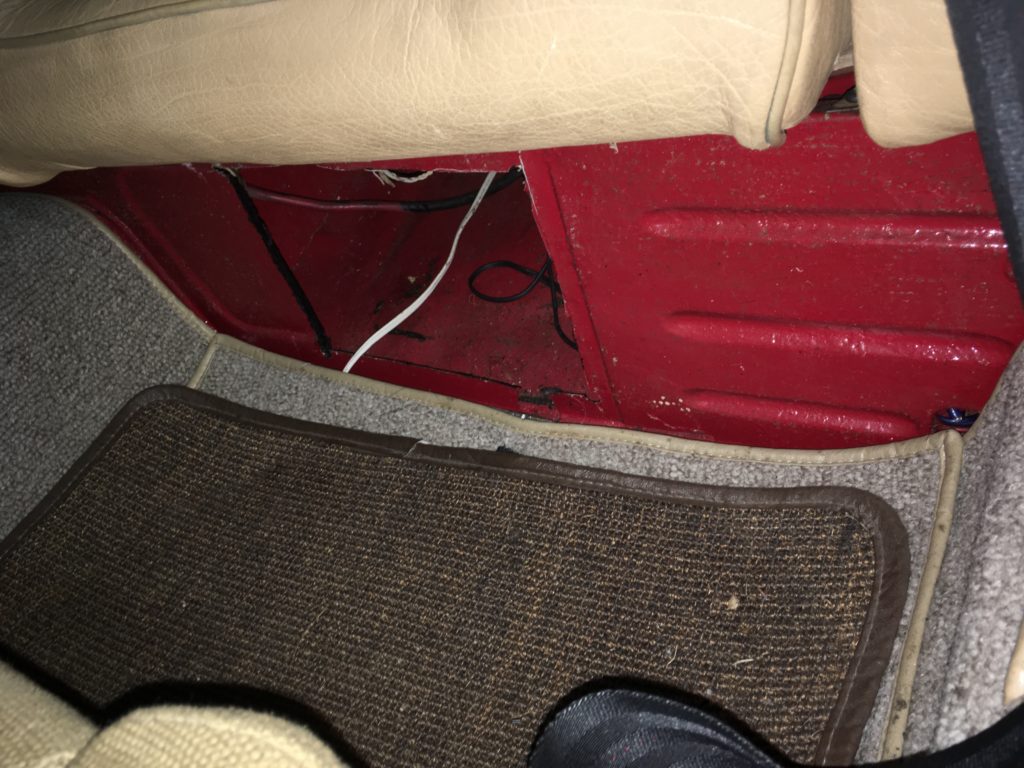
Holes I cut in the E9’s kick panels. Yeah, I’m not proud.
I lived with that system for about a dozen years. Despite its ADS-Alpine pedigree, I never really liked the way it sounded; something about the space in the trunk under the 300i’s set up an odd resonance. I was told that there was a way to tune it out with proper equalization, but I didn’t want to add what was then another box. I ripped out the subs and tried the 300i’s below the back seat. It killed the annoying resonance, but they were firing at my butt and losing a lot of high end. I took to tossing the 200C’s in their die-cast metal boxes on the back deck when I had a road trip.
At some point in the 1990s, my ardor for car audio began waning. The five-to-ten-year-old BMWs I was buying for daily drivers had acceptable sound systems, and I found that with all the wind noise in my vintage cars, I had to get the volume up so high to hear music above the background that it was fatiguing.
However, when I began taking long road trips to the Vintage and other events in 2010, I experimented with plugging my iPod into an inexpensive Cambridge Soundworks PC Works subwoofer and satellite speakers. The idea was that the subwoofer could run off the 12-volt cigarette lighter, making it portable if I wanted to take it out every night, and low-value if I didn’t. It worked well and actually sounded pretty good, but I found myself mostly running for hours with the music off so that my brain could do the quiet percolation thing it so desperately needs.
For the daily drivers, as we all know, BMW was pretty slow in adopting up-to-date audio technology. My 1999 Z3 M coupe still has the original cassette deck (I installed a proper iPod adapter when I bought it in 2005). The E39 530i Sport was the first BMW I owned with a CD player, but it’s never worked. Nonetheless, it has the best sound system of any car I’ve ever owned, and I installed an aux jack in it. I do tend to have the sound on in the E39 while I drive. The M coupe, for some reason, doesn’t sound nearly as good, even though they both have the premium sound package. The sound system in my 2004 X5 Sport is pretty good, but, like the M coupe, for some reason it’s not as spot-on as the E39.
Getting back to the E9, when I installed air-conditioning in it in 1999, the original non-a/c console had to come out in order to make room for the a/c evaporator assembly. With it came the antiquated Alpine cassette deck and Benzi Box. I was able to find a used E9 air-conditioned center console, but not a center faceplate; they were, and still are, hundreds of dollars. I saw one on eBay and bid on it and won, but I didn’t realize that it was from an E3 (Bavaria). They look very similar, but they have eight vent slots instead of seven, and when installed in an E9, they put the radio too low. At the time, I bought a Pioneer CD player with the least-obtrusive black panel I could find, and installed it. I’ve regretted it ever since. I rarely used it, and it looked wrong.
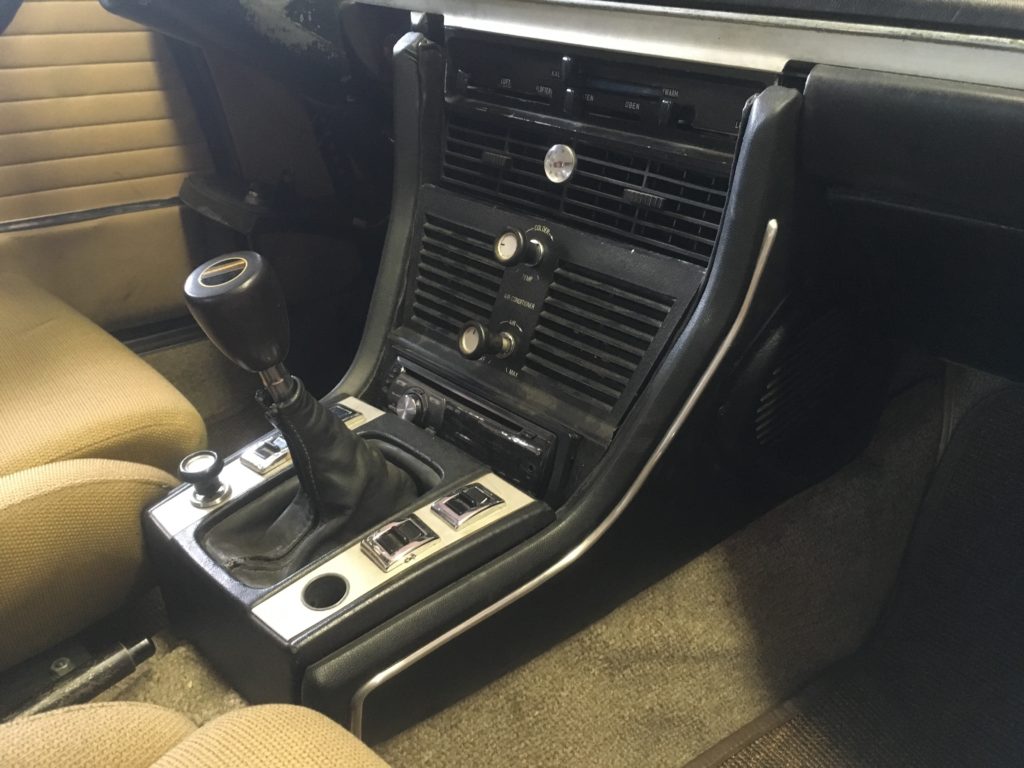
The E3 faceplate in my E9. Yup, too low.
Last spring, after I pulled the E9 out of storage, the a/c wasn’t working. I thought the problem was the expansion valve, so I pulled out the console and the evaporator assembly (just about my least favorite job in the entire automotive world) to replace it. I vowed that I wouldn’t put the incorrect faceplace and time-traveling CD player back in in the car. But in a world (my world) of finite resources, I badly wanted to cost-contain this project. After all, a correct radio would just be for appearance; I wasn’t looking to actually listen to whatever I was installing. Fortunately, that brought the cost down a bit, as non-functional old Blaupunkts are cheaper than working ones. (And yes, I know all about Bluetooth-enabling old radios; you don’t need to deluge me with options I’m never going to select.)
I found a cool one, a Blaupunkt Nürnberg M11. Shipped from Europe, it was about $72. It doesn’t work, and I don’t care. And no, I don’t know what that orange button does (well, yes I do; it does nothing, because, you know, the radio doesn’t work.), but I liked the dot of contrasting color. I’ll be happy to see it in the car.
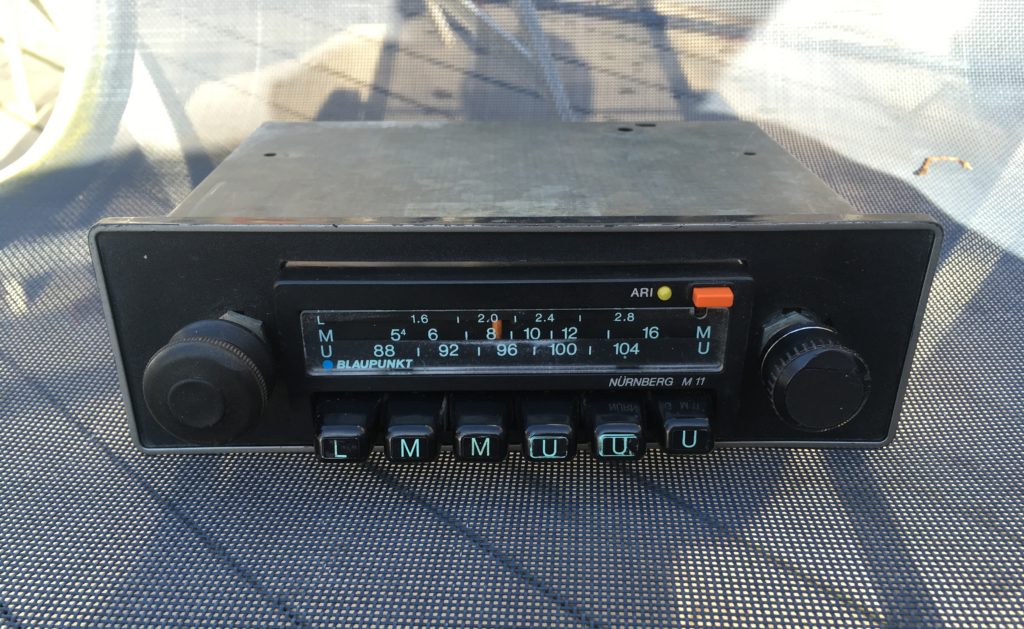
It doesn’t work. I don’t care.
Now, when you try to resurrect the look and feel of period-correct audio in a car, the radio is actually one of four things you need. There’s also the faceplate, the bezel (or surround), and the knobs. I never realized until our colleague, eagle-eyed Delia Wolfe, commented on a 2002 being sold on Bring a Trailer that the radio and a/c had the proper “BMW knobs” with silver centers that matched the dashboard controls and each other; it’s a really nice touch to have this correct. When I looked at the cars in my garage, I was delighted to find that Kugel, my ’72 tii (since sold), and Louie both have BMW knobs, as does the recently-added Hampton.
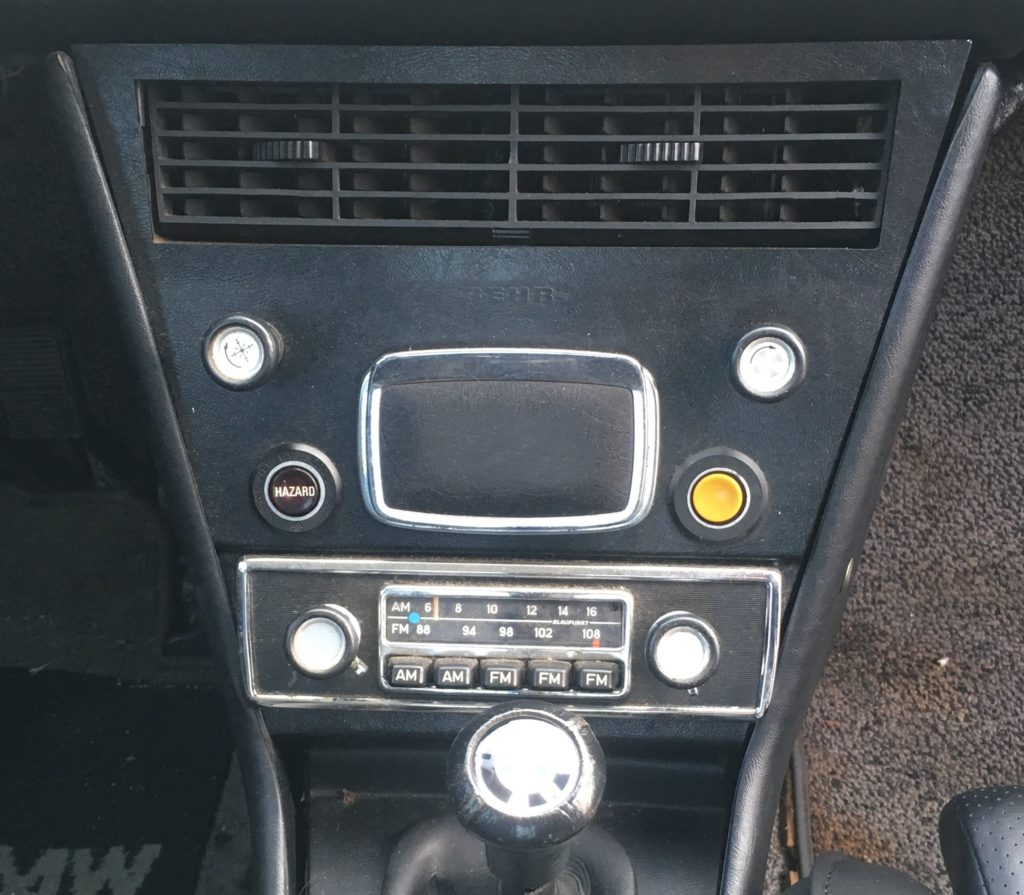
The radio, faceplate, bezel, and BMW knobs (on both the radio and the a/c) on my recently-sold 1972 2002tii Kugel all match.
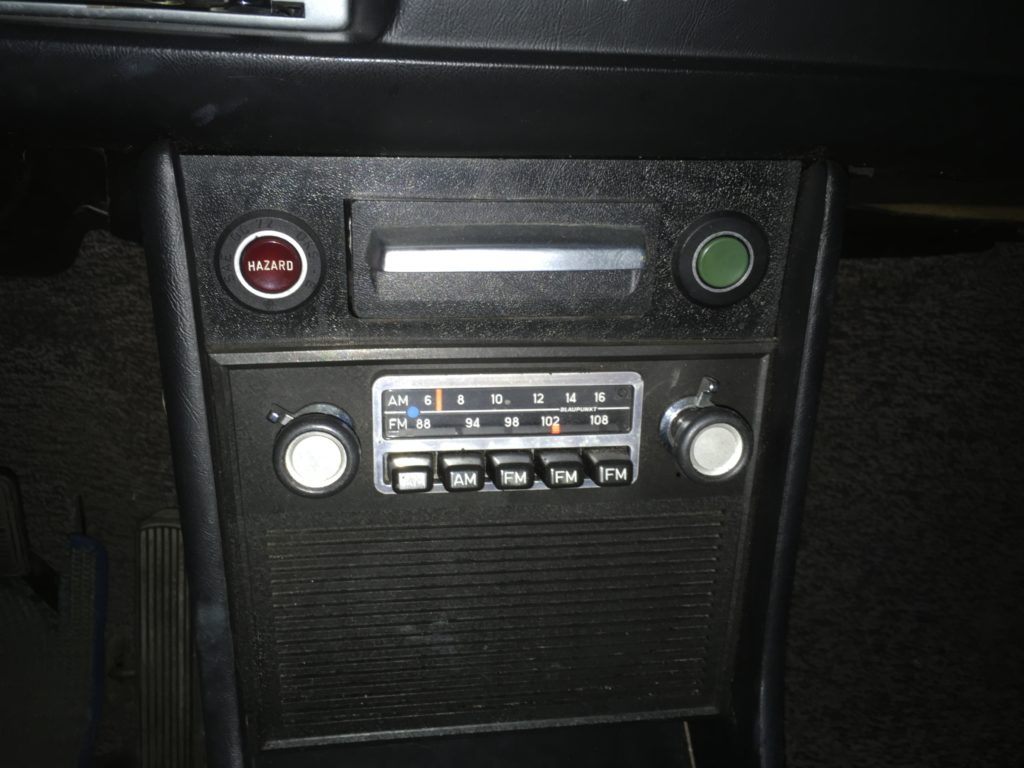
BMW knobs on Hampton.
As you can see, my Nurnberg M11 may have had a cool orange button, but it did not have BMW knobs. When I looked to find them online, I found that they’re expensive and rare. Then, out of the blue, after I posted about this on Facebook last fall, a pair of BMW knobs arrived in the mail, courtesy of my good friend Andrew Wilson.
So: I have the radio. I now have the knobs. I have a bezel—two, actually; there’s the one pictured that the M11 came with, and an original one I bought, like the one shown in Kugel, that has a little more chrome bling.
That leaves only the faceplate. Original ones are still hen’s-teeth rare and ridiculously pricey, but a fellow named Markos on the E9 forum is 3D-printing them and selling them for $225 shipped. If there’s any money left after the winter projects on Hampton and the Lotus, I’m going to spring for it.
It’s not accidental that my pendulum swing in car audio mirrors the general trend with vintage cars of the market wanting the original audio system, or at least one that doesn’t look like it time-traveled from the wrong century (I love seeing descriptions of high-dollar ’60s and ’70s cars with the comment “unfortunate aftermarket radio in dashboard.”)
I’d say that no matter how much nostalgia I have for hearing Love Is Alive, I draw the line at an eight-track, but I can’t help but end this with the following photograph from Sharkfest in 2014. This was in the center console of a mint Polaris 3.0CSL that was on display in the BMW Zentrum. It is, however, missing the BMW knobs—and, I believe, the correct surround.
Of course, T. Rex in an E9 CSL totally trumps anything.—Rob Siegel
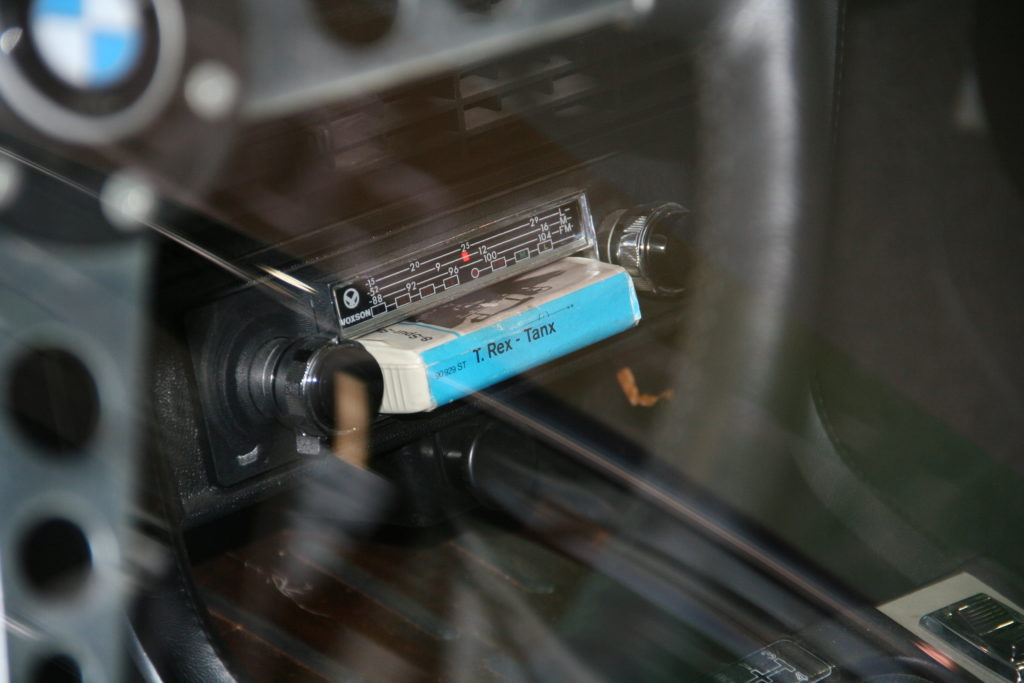
If you diss the eight-track, you’re dissing THIS.
Rob’s new book, Resurrecting Bertha: Buying Back Our Wedding Car After 26 Years In Storage, is available on Amazon here. His other books, including his recent Just Needs a Recharge: The Hack MechanicTM Guide to Vintage Air Conditioning, are available here on Amazon. Or you can order personally-inscribed copies of all of his books through Rob’s website: www.robsiegel.com.

